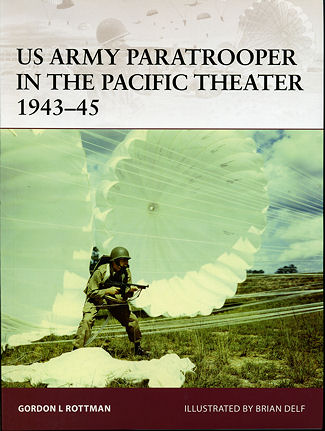 When one
thinks of US paratroopers, one is initially drawn to the vast number used during
Overlord and the even larger number deployed during Market Garden. However,
Europe and the Mediterranean were not the only place that the US Army used
paratroop forces. True, in the Pacific, they were not used until the last years
of the war and the operations were small compared to those in Europe, but they
were used with great success in a climate that turned out to be a lot less
hospitable to combat troops than was Europe.
When one
thinks of US paratroopers, one is initially drawn to the vast number used during
Overlord and the even larger number deployed during Market Garden. However,
Europe and the Mediterranean were not the only place that the US Army used
paratroop forces. True, in the Pacific, they were not used until the last years
of the war and the operations were small compared to those in Europe, but they
were used with great success in a climate that turned out to be a lot less
hospitable to combat troops than was Europe.
These troops were used in operations late in the campaign in New
Guinea and for the rest of the war in the Philippines. In these jungle
locations, it was as much a battle against the elements as it was against the
enemy. The troops were not equipped as well as they would have liked to battle
in the hot, humid jungles of these two locales, and I would daresay that there
were as many casualties due to medical issues as there were from combat against
the ever weakening Japanese defenders.
Author Gordon Rottman takes an interesting tack in presenting this
book in the Warrior series from others. As you may know by now, there are key
areas that are covered in each book of this series and this is all accomplished
by concentrating on one unit, the 511th Parachute Regiment of the 11th Parachute
Division. This was one of the two regiments in this division that performed most
of the drops and other combat in which the division was involved.
We follow a typical volunteer through his initial training, jump
school, specialist trainging, and finally into combat. We see how he feels about
himself and his sense of pride and belonging at being a paratrooper. These men
had uniforms that were different from the rest of the army and so they stood out
as being part of an elite group.
To show how these men performed in combat, two major operations are
covered in greater detail. One is the jump onto Corregidor to retake this island
from the Japanese. These men had to be dropped in two 'shifts' due to lack of
transport. They were also up against many times more Japanese than they had
anticipated. Drop zones were small and caused considerable difficulty. The other
was a relatively long term campaign in the jungles of Leyte during late 1944. In
this one, it was as much the conditions as it was the Japanese that had to be
overcome as the fighting was in very hilly jungle terrain. Both events are
superbly reported, making this a book that both entertains and informs. A book
that puts the spotlight on men and units that are rarely covered by other books.
A book that I know you will like.
January 2013
For more on the complete line of Osprey books,
visit www.ospreypublishing.com
or contact them at Osprey Direct, PO Box 140, Wellingborough, Northants,
NN8 2FA, UK. In the US, it is
Osprey Direct at 443 Park Avenue South, New York, NY 10016, where you can
get a catalogue of available books.
If you would like your product reviewed fairly and quickly, please
contact
me or see other details in the Note to
Contributors.
 When one
thinks of US paratroopers, one is initially drawn to the vast number used during
Overlord and the even larger number deployed during Market Garden. However,
Europe and the Mediterranean were not the only place that the US Army used
paratroop forces. True, in the Pacific, they were not used until the last years
of the war and the operations were small compared to those in Europe, but they
were used with great success in a climate that turned out to be a lot less
hospitable to combat troops than was Europe.
When one
thinks of US paratroopers, one is initially drawn to the vast number used during
Overlord and the even larger number deployed during Market Garden. However,
Europe and the Mediterranean were not the only place that the US Army used
paratroop forces. True, in the Pacific, they were not used until the last years
of the war and the operations were small compared to those in Europe, but they
were used with great success in a climate that turned out to be a lot less
hospitable to combat troops than was Europe.